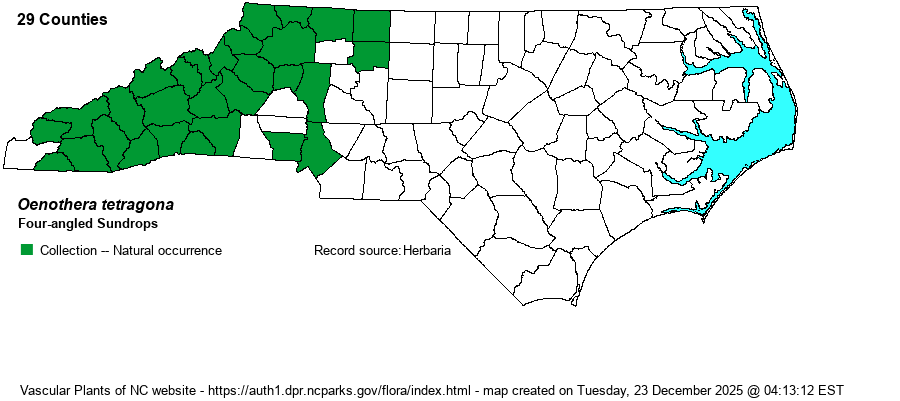| Author | Roth | |
| Distribution | Weakley (2024) moves this taxon into the "new" or "uncertain" O. hybrida. However, his map for O. hybrida shows Mountains only, so the fate of the Piedmont records assigned to O. tetragona is unclear. There seems to be little concurrence on what O. hybrida is and whether it is worthy of a full species status. Thus, the website editors are keeping O. tetragona on the list, especially as hardly any herbaria have moved this species to another name.
Throughout the Mountains and the western Piedmont, east to Stokes, Forsyth, Iredell, and Gaston counties. Note that a number of references do not consider this as a valid species, including it within O. fruticosa. With Weakley (2022) pulling O. hybrida out from this species, the true range of the "new" tetragona is not clear; that other species occurs in the middle and higher elevations only.
This is a more Northerly species, ranging from eastern Canada south to GA and TN.
| |
| Abundance | Frequent to common in the Mountains and foothills of the Piedmont; probably uncommon into the lower portions of the Piedmont, but as O. fruticosa is so common there, the abundance level of O. tetragona is not clear. Note that NatureServe does not consider this as a valid species (GNA rank), so the website editors are assigning the default G5 Global Rank, as it is certainly a common entity, whatever it is named. | |
| Habitat | This is a species of wooded borders, opening in upland woods, and other dry to mesic edges -- apparently in very similar habitats as O. fruticosa, with which it is frequently confused. | |
| Phenology | Blooms from May to August, and fruits shortly after flowering. | |
| Identification | This species is an erect herb that grows to 1-2 feet tall, with a few small branches in the upper portions. The alternate stem leaves are rather scattered, lanceolate to narrowly elliptic, about 2 inches long and 1/4-inch wide, with entire margins. The quite large flowers grow from upper leaf axils, generally in a dense inflorescence, with 4 bright golden-yellow obovate petals that produce a flower about 1.5 inches across. Each petal has a notch at the apex, thus a flower looks like it has 8 lobes. Normally, this would be a very easy species to identify, as common as it is. However, present within its range in the state is the extremely similar O. fruticosa, in good numbers. O. tetragona has its capsules oblong or elliptical, widest near the middle; O. fruticosa has the capsule clavate or obovoid (club-shaped), widest above the middle. Also, O. tetragona has glandular hairs on the capsule, whereas O. fruticosa has hairy not glandular capsules. Lastly, Weakley (2018) says that O. tetragona has leaves more or less dentate, versus generally entire in O. fruticosa. Note that each of these two species has multiple varieties in the state, and these features may not apply to some of the rarer varieties! Of these distinctions, the shape of the capsule is going to be the most useful character -- elliptical/oblong in tetragona versus club-shaped (wider toward the apex) in fruticosa. This is an easily encountered species in the mountains and foothills, and hopefully you can make identification from the capsules, if any are present. But, if one of these showy, knee-high plants is seen in the eastern two-thirds of the state, is almost surely will be O. fruticosa. | |
| Taxonomic Comments | As with O. fruticosa, this species -- if even considered a good one at all -- has several varieties. Weakley (2018) lists var. brevistipata, var. fraseri, and var. tetragona -- all numerous in the western part of the state. Thus, for the public and most biologists, this level of distinction -- a total of six varieties of these two species, is far too much splitting of hairs, and only diehard botanists will be interested at this level of detail.
| |
| Other Common Name(s) | Northern Sundrops, Glaucous Sundrops | |
| State Rank | [S4?] | |
| Global Rank | GNA [G5] | |
| State Status | | |
| US Status | | |
| USACE-agcp | | |
| USACE-emp | | |

